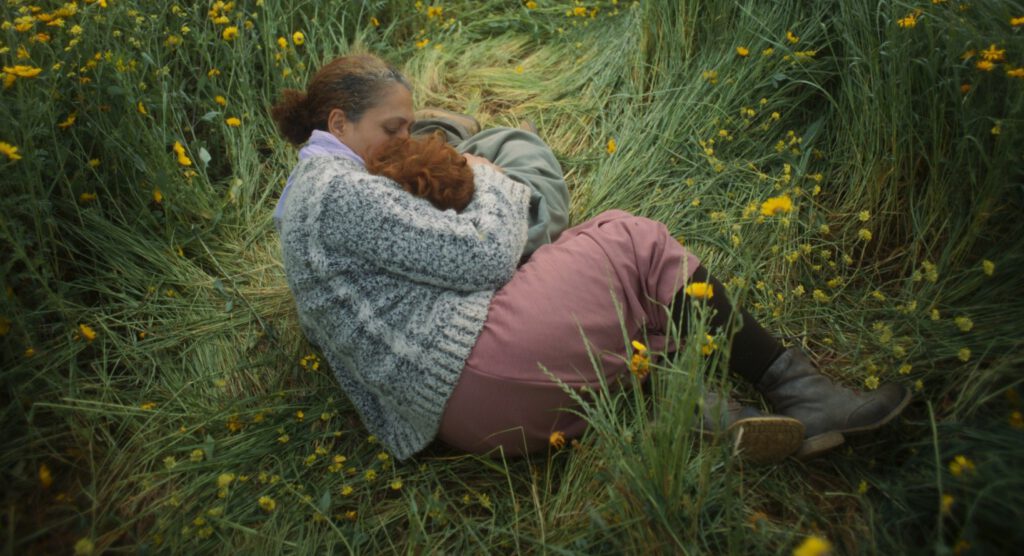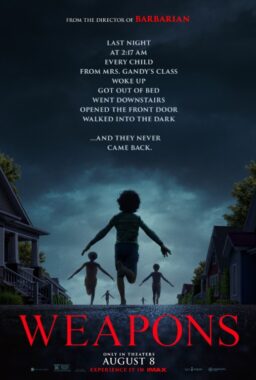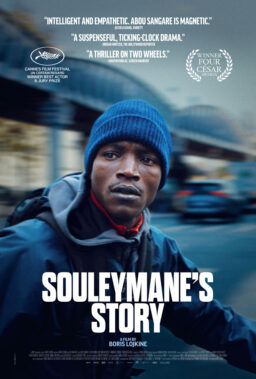In Berlin’s Main Competition and its Panorama section are three films centering mothers: the worries they have about their children, the memories of their lived experiences, and the ache they feel when they lose a child. These maternal stories are told through flights of magical realism, docufiction, and harsh reality to get inside of the panic, distress, and liberation experienced by these women.
Aicha (Salha Nasraoui) and her husband Brahim (Mohamed Hassine Grayaa) leave with their young son Adam (Rayen Mechergui) to attend a wedding. Their two other sons – Medhi (Malek Mechergui) and Amine (Chaker Mechergui) – stay behind, telling their parents they’ll catch up to them at the celebration. The two young men never show up. They have left their homeland to join a radicalized war, pushing Aicha and Brahim to blame each other for losing their sons. A few months later, Medhi returns not with his brother, but with Reem (Dea Liane), a pregnant Syrian woman clothed in a purple niqab who he claims to be his wife. While Brahim is still furious, Aicha is apprehensively hopeful, even as something with Medhi doesn’t appear to be quite right.
Set on the wind-swept coast of northern Tunisia, “Who Do I Belong To,” writer/director Meryam Joobeur’s feature directorial debut, is an anxiously lyrical, magical realist narrative separated into three harrowing chapters. The first section, “Aftermath,” chronicles Aicha and Brahim coping with their sons leaving. Aicha tells Adam his brothers have gone to Italy to look for work, but even at such a young age, Adam knows the truth. Bilal (Adam Bessa), a local cop and family friend, becomes a surrogate brother to Adam. Cinematographer Vincent Gonneville sports a patient lens, composing frames whose short depth of field suggests the world outside of Aicha and Brahim’s internal angst barely exists.
The return of Medhi, particularly in chapter II: “A Shadow Emerges,” brings new questions: Why did Medhi and his brother leave? Where did Reem come from? Where are the men in the town suddenly disappearing to? Aicha is often stricken with visions that offer some clues to these queries, but there is slipperiness to the truth. Nasraoui is a firm presence in a film that from its precipitous setting to its intrusive photography has a fogginess to it. She keeps you transfixed even when you begin to feel the slightly florid film’s near-two-hour span. “Who Do I Belong To” is also such a bracing and assured work, one given further texture through an immaculately evocative sound design, it allows for Aicha’s maternal fears and Medhi’s gnawing radicalism to make for a stirring debut by Joobeur.

I have spent much of Berlin talking to people about a tiny, under-the-radar film that is absolutely worth their time: “Memories of a Burning Body,” the Costa Rician writer/director Antonella Sudasassi Furniss’ swift tribute to the type of women she knew in her family and their possible sexual journeys hasn’t left my mind. Docufiction pitched as the kind of conversations Furniss wishes she had with her grandmothers, the film features interviews with 68-year-old Ana, 69-year-old Patricia and 71-year-old Mayela. The trio of women grew up during a sexually repressive era, where the bodily responsibilities of a wife or a partner were defined by a selfish patriarchy. We never see any of the women, but we hear their voices, delicately weaved together as they share their experiences growing up, marrying, having children, and growing old.
While they provide the skeleton of the narrative, the visual component of “Memories of a Burning Body” is handled by a few actors, primarily Sol Carballo, who act out the powerful recollections provided by the subject. The moment when they met their first love or when they challenged for a divorce is depicted with delightful imagination and through luminous photography; Carballo is often seen shuffling around a spacious home, going through rooms, pictures, and other items that trigger memories of former obstacles. Topics that were once taboo to discuss or weren’t taught to young women at all — what constitutes rape and the normalcy of domestic violence — are also touched upon. As is the specter of religion keeping women in a physically vicious relationship.
The trio of women speak with candor and wit, offering just as many zingers that engender a laugh as realities that make you sit in horror. But what is most fulfilling about Furniss’ film is hearing these women speak about the freedom — sexual or otherwise — they have found in their later years. They all sound confident, defiant, and sage — reminding you in a short 80-minute span that the beginning of one’s life doesn’t have to spoil the end.

I can barely remember my own birthday, but I know exactly which festivals and which years I saw certain movies. I still remember seeing Gustav Möller’s inventive Danish thriller “The Guilty” at the Music Box Theater as part of the Chicago Critics Film Festival. That film about a Danish cop assigned to an Emergency Call Center, who receives a panic-stricken call from a woman seemingly imperil, was so sturdily built around such a simple one-room set, I knew I’d be front and center for his next picture. So you can imagine my disappointment upon seeing his follow-up, “Vogter” (or “Sons”), and being totally unenthused.
Möller has a way with premises, I’ll give him that. And this one is just as unique, just as complicated and as morally complex as “The Guilty.” A beloved prison guard, if such a person exists, Eva (Sidse Babett Knudsen) teaches meditation and math lessons to the incarcerated men at her penitentiary. Those feel-good vibes change when the unpredictable, wildly violent Mikkel (Sebastian Bull) arrives as a new transfer. No one knows it, but Eva once had a son. He was murdered in prison by Mikkel, which, of course, creates a conflict of interest. Nevertheless, Eva keeps their past a secret (it helps that Mikkel has never met her before) and asks to be transferred from her quaint cell block to the more dangerous zone housing Mikkel. While there she tries to make his life a living hell until she beats him so savagely, he ends up in intensive care. The assault gives Mikkel his opening, if Eva will grant him favors – more time outside, access to other activities, and even a day pass – he promises not to press charges.
Möller has never been afraid to get in close to his actors: Sharp close-ups capture a vivid performance by Knudsen that is as twisting as her grief. Bull is also captivating. At times, he is trying to recapture the kind of menacing presence James Cagney had in “The Public Enemy” (there’s even a winking nod to it involving a cake to the face). Möller’s film attempts to question if nature or nurture decides potential criminality and whether some men aren’t capable of rehabilitation. The latter theme was common to Cagney gangster pictures, films where the actor played characters who were always going to keep on killing unless they were stopped. It’s difficult to place that kind of sentiment in a modern narrative, especially when the nature and tactics behind imprisonment are constantly being questioned and particularly when Mikkel, as a character, misses what made Cagney feel so dangerous. He was charming, and in that amiable charm lurked an unquenchable darkness. In trying to parse the morals of a woman learning to coexist with the killer of her son, Möller arrives at a bleak ending that undercuts his critique of the dehumanization inherent to so many prison systems.












